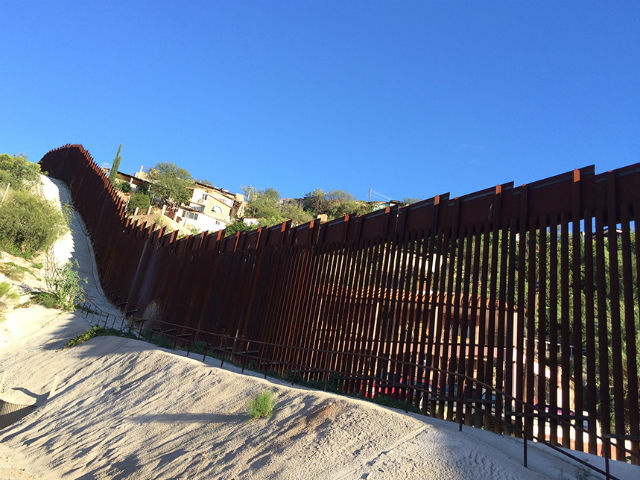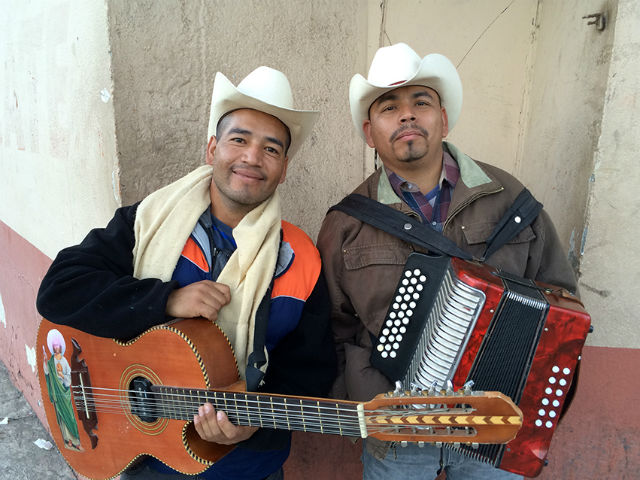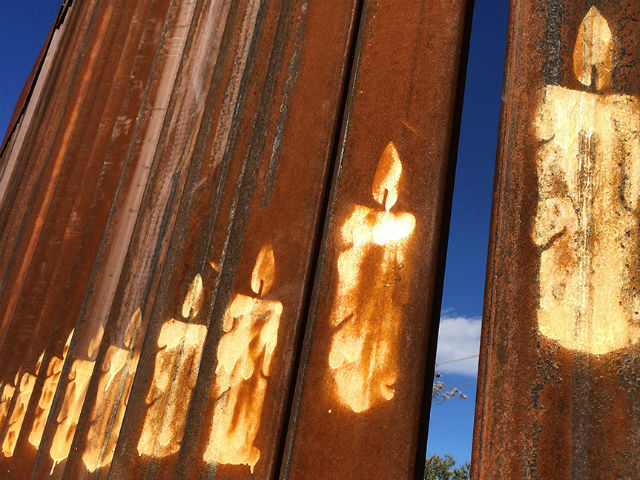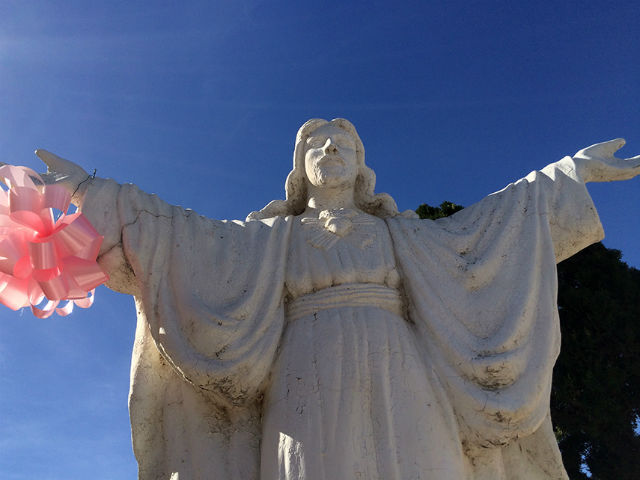In the last 35 years, I’ve walked into the Arizona/Mexico border town of Nogales too often to count.
Like many Mexican communities, Nogales makes little effort to conceal its considerable poverty. Some of the sidewalks are cracked, streets can be uneven and layers of paint are peeling from houses and business facades. And while that may be a visitor’s only impression, it’s not mine. I enjoy exploring the streets, renewing old acquaintances or grabbing lunch at La Roca, the ornate restaurante built into the side of a hill. Best of all, if you’re in Arizona, Nogales is only 40 minutes from Tucson and about two hours from Phoenix.
The hundreds of ocean blue, lime green and Bazooka bubble gum pink residences that overlook downtown, the aromas that emanate from curbside grills and lunch carts, and the Tex-Mex polkas that pour from open windows and doorways are like getting letters from a long-lost friend. The Nogalans are friendly, hospitable people who delight in concluding every sale by getting a $1 tip "for my Coca-Cola!" They’re excellent conversationalists who love to talk about the weather, walking directions, their merchandise or what’s going on en los Estados Unidos. They’ll talk about anything except las drogas (drugs). A transcript of that particular topic could fit in a space somewhere between a postcard and the head of a pin.
That there are thousands of statues, murals, decals or other representations of the iconic Our Lady of Guadalupe speaks volumes about a people torn between the desire for salvation and the need to eat. Steady streams of penitents pass hourly through the doors of the catedral on Avenida Mateo Lopez. Every weekday afternoon, an enthusiastic sea of Catholic school uniforms spills out onto the street, the young men and women laughing and talking while dodging pedestrians, vendors and traffic.
In the midst of fences, guns and Jesus, Nogalans simply persevere.

When I made that first trip in August 1980, I had no idea it was the beginning of a lifelong love affair. My footsteps were added to countless others going back more than 1,000 years. Once called El Camino Real, this king’s highway held armor-clad conquistadors as they searched for gold and gems. Alongside the treasure seekers walked indefatigable Catholic priests who built a chain of missions and churches that stretched all the way into northern California. 10,000 mostly black Buffalo Soldiers of the Civil War’s 25th Regiment, 19th-century railroad barons straight out of "Hell on Wheels" and the armies of Mexican Revolution warrior Pancho Villa were but a sampling of those who forged the narrow gateway between Mexico and Arizona. In recent decades, this king’s highway now serves workers in the ever-burgeoning drug trade as well as untold numbers of Mexican citizens that are seeking a better life for themselves and their families.
Nogal actually means "walnut," and the north-south crossings eventually flattened an immense grove of walnut trees, leaving behind myriad of mercantile establishments along with an ever-evolving series of gates, fences, turnstiles and barricades. Currencies of all forms and denominations have changed hands here for ten centuries, and there’s no sign of that stopping in the foreseeable future. In fact, the simple gateway once guarded by a handful of sentinels now comprises several thousand police officers, border patrol officials, drug enforcement agents, customs inspectors, marshals and more. A large number of these employees monitor the commercial traffic straddling the border.

Freight trains with an annual cargo value of nearly $15 billion travel north through Nogales loaded with copper, beer, electronic components and automobiles assembled at the Ford plant in Hermosillo. In turn, trains from the United States travel to Mexico carrying coal, farm equipment, iron, steel and industrial chemicals. All trains stop at the Rio Rico depot where they undergo a rigorous inspection that includes x-ray scans, thermal sensors and physical searches by the customs agents.
"In a year, we might pull maybe 200 people off the trains," said one customs official, referring to undocumented individuals attempting to cross the border. "That's not such a big deal. It's really the drug smuggling we're looking to curtail."
The official said hollow spaces, such as the inside of car tires, were favorite areas to conceal illegal substances. "We check everything," he said. When asked if the official spent any time on the Sonoran side, the answer was emphatic. "I never go over there," he said. "Those people know us, and we're marked. There's a bounty on my badge. It's worth $5,000 if someone can get it away from me."
Commodities that are shipped via truck are routed through the Mariposa Gate a mile west of the pedestrian crossing. Peppers, tomatoes, beans, rice and hundreds of other produce items bound for the U.S. account for about $5 billion each year. As staggering as those figures are, they’re down more than 10 percent for each of the last five years. Keeping track of all the traffic from Mexico into southern Arizona and back has become an industry unto itself.
Visitors who walk across to Nogales are greeted by one of the estafadores callejeros, street hustlers who act as mobile concierges. If you need a taxi ride, a prescription filled at a farmacia, an escort to one of the 50-plus dental clinics or the best deal in town on a souvenir, these gentlemen work for tips, usually $5 or less. They’ll even get you past the doorman at one of the clubs east of the railroad tracks, although that's not an area you want to be after dark.
I’m on a first-name basis with Jonathan, who hustles on Calle Campillo. "I work with the cartel," he told me one afternoon while waiting for a customer to happen by. I asked why he’d work the streets if he was in with the cartel. Jonathan explained that working "with" the cartel was not the same as working "for" them.
"When you work for the cartel, you make money," he said. "When you work with the cartel, you’re allowed to remain in business."
Another day, I was sitting on a bench in the Plaza Heroica when a friendly, 30-ish guy asked me for some money. My Spanish is just good enough to let these guys know I’m not really a tourist. I said, "No, pero me voy a comprar una Coca Cola." Oscar readily accepted the offer of a Coke, and we talked for about an hour.
In the course of the conversation, he outlined a way for both of us to make some money. "De Verdad? ¿Cómo?," I asked politely, as if I didn’t know. Oscar spoke of a place on the border fence where a rusty red Chevrolet marked a spot not covered by the surveillance cams. His plan was to throw a duffel bag of contraband over the fence to Short Street near the Morley Avenue shopping district. Once it landed, a compadre would retrieve it.
I told this story to Terry Kirkpatrick, a retired border agent and the author of an entertaining memoir, "Sixty Miles of Border." In between puffing a Montecristo No. 2 cigar, Terry chuckled at the thought of a 5-foot 5-inch guy trying to throw a 40-pound knapsack over the 12-foot fence. Kirkpatrick said there were no surveillance camera gaps, and even if there were, officers on 10-speed bikes, foot patrols and Jeeps would see that bag coming a mile away. "I hope you told the guy to get a regular job," he added.

At last count, about 30,000 Nogalans were gainfully employed in the Zona Technologico, an area where General Electric, Motorola, Black and Decker, and many other companies have manufacturing facilities. So contrary to popular misconception, the Mexican people are not all involved in the business of selling drugs.
Nogales’ fame as a popular American tourist destination grew in the 1920s when notorious folk hero/bank robber John Dillinger was spotted there while hiding from the law in Tucson. A galaxy of Hollywood’s biggest stars also found time to visit – most notably actor Stewart Granger, who purchased Yerba Buena, a 10,000-acre ranch on the American side of the border.
Granger’s guests included his favorite drinking buddy John Wayne along with Clark Gable, Bob Hope, Richard Burton and Elizabeth Taylor, just to name a few. Here, film colony personalities could relax without being photographed by the paparazzi or swarmed by enthusiastic admirers. From Yerba Buena, it was a 10-minute drive to the Mexican side of Nogales where stars and their entourages unwound at La Caverna, a nightclub located in the entertainment district along Calles Elias. White-jacketed waiters served cocktails and champagne in a unique environment illuminated by sparkling chandeliers and elegant sconces. A portion of the Cavern exists today as La Roca and is still a popular destination for dining or hosting an event.
As the Western film genre passed out of popular favor, fewer movies were made at Old Tucson, a large movie set located near Tucson’s Sonoran Desert Museum. As a result, studio executives and the Hollywood crowd found other places to vacation. By 1969, the aging Granger had completed the sale of his Yerba Buena ranch to a group of investors who transformed it into the Kino Springs golf resort. Granger’s luxurious home was incorporated into the facility’s clubhouse.
Nogales continued to flourish as a fun place for Americans to haggle for leather goods, jewelry, liquor and other merchandise. 1969 was also the year that the United States government, under a mandate from President Richard Nixon, launched an assault on the Mexican marijuana industry in an attempt to stem the steady flow of pot into this country. Dubbed "Operation Intercept," the lengthy inspection of cars coming from Mexico into the U.S. caused traffic to back up for hours at all major border crossing points. Nogales was earmarked as having some of the longest re-entry lines, with irate motorists blowing their horns as they waited for permission to cross. Within 20 days, "Operation Intercept" was shelved due to an overwhelming number of public complaints.
Nixon faced a hostile press and defended the initiative as the beginning of a Mexican/U.S. war on drugs. Although well-intended, Nixon’s efforts probably did more to turn the spotlight on the money that could be made from a successful smuggling enterprise.

As with any city that relies on tourism as a major economic engine, Nogales endured a fairly typical set of highs and lows over the years. One of the sharpest economic downturns occurred in 2009 when the Sinaloa and Beltran Levya cartels engaged in a brief but vicious fight for the rights to move a million or more pounds of narcotics into the U.S. on an annual basis. The Sinaloans prevailed, and just as quickly as it erupted, the border violence vanished. But the public relations nightmare continued with sensational television news pieces and inaccurate social media postings based more on hearsay than fact.
As the tourist visits dwindled and the influx of dollars dried up, the merchants and residents of Nogales felt the pain. Popular, full-service eateries like El Greco and El Cid went under. Jewelry and art establishments, such as Maya de Mexico, closed for good. The subsequent shuttering of numerous gift shops, cigar stores and discount liquor emporiums in the heart of the tourist zone shook Avenida Obregon to its core.
One local business owner said the myth of Nogales being dangerous to tourists was being propagated by America. "The State Department issues regular bulletins that portray Nogales in a negative light," he said. "Advising people to get off the streets before 4 p.m. has a tremendous impact. Everyone heads back to Tucson or wherever they're staying."
Enter the energetic and charismatic Temo Galindo, who was elected mayor of Nogales in June, 2015. The 39-year-old politico was publicly critical of the U.S. statements and policies toward his country long before he took his oath of office. In 2010, he organized protests and encouraged Mexican citizens not to patronize businesses such as Walmart and McDonald’s on the American side of the border.
His strategies not only worked, they propelled Galindo into the leading mayoral candidate spot. One of his first initiatives upon election was to create a successful cooperative alliance between Mexican and American police agencies that patrolled the border. At the same time, Galindo retrained his own police officers to become helpful, welcoming ambassadors to tourists visiting the city. He also authorized the creation of several new zocalos, public plazas designed to host festivals, dances and an annual Day of the Dead celebration.

Galindo might just be the best thing to happen to Ambos Nogales, the towns on each side of the border. Under his leadership, new spaces are being created for shops and restaurants along the proposed plazas. Already the tourists are coming back, pleased to find a safe, friendly and fun place to spend the day. The little crossroads shared by Mexico and America amid a grove of walnut trees nearly one thousand years ago has not only persevered, but distinguished itself as the best, most exciting of the 47 U.S./Mexico entry ports to visit.
I’ve been promising to take a group of photographer friends across for a day of exploring. I’m anticipating great pictures will be made as they focus their lenses on everything that’s happening in this brave little world entering its second millennia.







